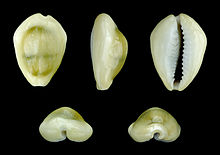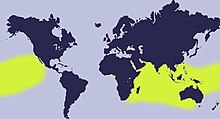Monetaria moneta
| Money cowrie | |
|---|---|

| |
| Live animal, with mantle visible | |

| |
| Five views of a shell of Monetaria moneta | |
| Scientific classification | |
| Domain: | Eukaryota |
| Kingdom: | Animalia |
| Phylum: | Mollusca |
| Class: | Gastropoda |
| Subclass: | Caenogastropoda |
| Order: | Littorinimorpha |
| Family: | Cypraeidae |
| Genus: | Monetaria |
| Species: | M. moneta
|
| Binomial name | |
| Monetaria moneta | |
| Synonyms[1][2] | |
| |
Monetaria moneta,
This species is called "money cowrie" because the shells were historically widely used in many Pacific and Indian Ocean countries as shell money before coinage was in common usage.
Description and characteristics
It is a quite small cowry, up to 3 cm (1.2 in), irregular and flattened, with very calloused edges and roughly subhexagonal. The color is pale (from white to dirty beige), but the dorsum seems transparent, often greenish grey with yellowish margins, with sometimes darker transverse stripes and a delicate yellow ring. The opening is wide and white, with pronounced denticules. The mantle of the live animal is mottled with black and off-white.
The shell of Monetaria moneta varies widely in shape and color, with some of these varieties having been described as full species. As a result, this species has numerous taxonomic synonyms.
-
The underside of a live Monetaria moneta with the mantle partially retracted
-
Same specimen, with mantle withdrawn
-
Shell
-
Dark-backed shell variant
Distribution

This is a very common species which is found widely in
Habitat
This cowrie lives in
Subspecies and forms
Subspecies:
- Monetaria moneta icterina (Lamarck, 1810)
- Monetaria moneta monetserpentis Lorenz, Chiapponi & Mont, 2012
- Monetaria moneta tuberculosa (Quoy & Gaimard, 1834)
- Monetaria moneta barthelemyi (f) Bernardi, M., 1861[4]
Forms:
- Monetaria moneta form erosaformis[5]
- Monetaria moneta form harrisi Iredale, T., 1939[6]
- Monetaria moneta form icterina Lamarck, J.B.P.A. de, 1810[7]
- Monetaria moneta form rhomboides Schilder, F.A. & M. Schilder, 1933[8]
- Monetaria moneta form tuberculosa Quoy, J.R.C. & J.P. Gaimard, 1834[9]
Human uses
The shell is used in
As money
Shells of this cowrie were commonly used as a
The
It was also traded to Native Americans by European settlers.
For divination
The shell is still used in divination rituals in some African religions.[3]
In the State of Kerala, in India, special money cowrie shells (which are known in Malayalam as കവിടി Kavidi) are used for divination as part of Hindu astrology, as Prashnam. For Prashnam, 108 shells of Monetaria moneta are rotated a number of times and the blessings of God and one's Guru are invoked. A portion of the Kavadis are separated and counted to find out the ruling planet at that time. The results of the Prasna horoscope (a horoscope formulated at the time of arrival of the persons) are compared with the results of the Prasnam, and the predictions are pronounced on that basis.
References
- ^ a b WoRMS : Monetaria moneta; accessed : October 20, 2010
- ^ "Monetaria moneta". Gastropods.com. Retrieved 20 October 2010.
- ^ a b c d Poutiers, J. M. (1998). Gastropods in: FAO Species Identification Guide for Fishery Purposes: The living marine resources of the Western Central Pacific Volume 1.[permanent dead link] Seaweeds, corals, bivalves and gastropods. Rome, FAO, 1998. page 503.
- ^ Gastropods.com : Monetaria moneta barthelemyi; accessed : October 20, 2010
- ^ Gastropods.com : Monetaria moneta erosaformis; assessed : October 20, 2010
- ^ Gastropods.com : Monetaria moneta harrisi; accessed : October 20, 2010
- ^ gastropods.com : Monetaria moneta icterina; accessed : October 20, 2010
- ^ Gastropods.com : Monetaria moneta rhomboides; accessed : October 20, 2010
- ^ Gastropods.com : Monetaria moneta tuberculosa; accessed : October 20, 2010
- ^ Hogendorn, Jan and Johnson Marion: The Shell Money of the Slave Trade. African Studies Series 49, Cambridge University Press, Cambridge, 1986.
- Verdcourt, B. (1954). The cowries of the East African Coast (Kenya, Tanganyika, Zanzibar and Pemba). Journal of the East Africa Natural History Society 22(4) 96: 129-144, 17 pls.
External links
- On-line articles with Cypraea moneta in the HAWAIIAN SHELL NEWS (1960–1994)
- cypraea moneta
- More habitat info
- Shell money
- Astamangala Divya Prasna an article about divination in Kerala using coweries.
- Photos of Monetaria moneta on Sealife Collection




